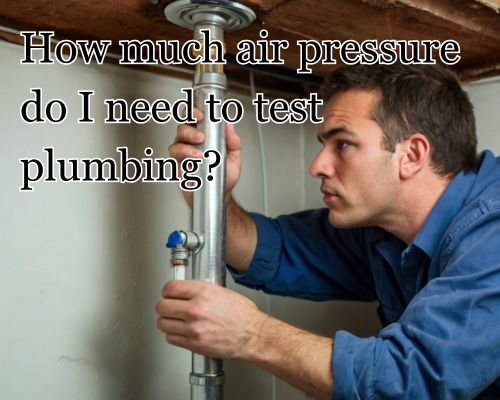When it comes to plumbing in Warragul, Victoria, understanding compliance isn’t just a matter of turning a wrench—it’s about ensuring water-tight integrity and safety across residential, commercial, and even semi-rural properties. One of the most frequently asked questions by both seasoned tradies and DIY renovators is: “How much air pressure do I need to test plumbing?”

This isn’t just a technical query; it’s central to preventing long-term damage, ensuring compliance with Victorian Building Authority (VBA) standards, and avoiding expensive callbacks. So, whether you’re laying pipe in a new build along Sutton Street, or retrofitting a charming weatherboard in Warragul North, let’s unpack what really matters when it comes to plumbing pressure testing in Gippsland.
Why Air Pressure Testing Is Critical in Plumbing Systems
Air pressure testing is a non-destructive way to verify that a plumbing system is sealed and won’t leak when water flows through it. It’s especially useful in new builds and rough-ins, where water hasn’t yet been introduced into the system. Here in Warragul, where seasonal rains and clay soils can put unpredictable stress on underground pipes, getting the initial pressure test right is critical.
The goal? Detect leaks early—before plastering, before tiling, before disaster.
So, How Much Air Pressure Do You Actually Need?
In Australia, including Warragul and wider Victoria, the standard air pressure for testing non-potable (waste or vent) plumbing lines is 35 kPa (5 psi), as per AS/NZS 3500 standards. For potable water systems, air pressure testing is less common and typically water testing (hydrostatic testing) is preferred for safety reasons. However, when air is used, it must never exceed 200 kPa (29 psi)—due to the risk of explosive failure.
Here’s a simplified breakdown:
| Type of System | Recommended Air Pressure | Duration | Testing Authority |
|---|---|---|---|
| DWV (Drainage/Waste/Vent) | 35 kPa (5 psi) | 3-5 min | AS/NZS 3500.2 |
| Potable Water | Up to 200 kPa* (if air) | 5-10 min | VBA / AS/NZS 3500.1 |
⚠️ Important: Use a calibrated gauge and check for pressure drop over time. Never overpressurize plastic pipe systems (especially PVC), as air compression can cause explosive hazards.
Common Mistakes to Avoid (Especially in Regional Builds)
1. Ignoring Local Soil Movement
In Warragul, local builders know that expansive clay soil can stress underground pipes. After heavy rainfall (common in the Gippsland region), ground shifts may compromise fittings. Conducting a thorough pressure test before backfilling is vital.
2. Not Accounting for Temperature Fluctuation
Air expands and contracts with temperature. On those crisp Warragul winter mornings, a pressure test done at 7 AM could show variation by 11 AM. To avoid false positives, always allow temperature acclimation before reading results.
3. Using Water When Air Is Required (and Vice Versa)
While hydrostatic testing is often considered safer, air testing is typically faster and cleaner. But using the wrong method for the wrong application leads to non-compliance. For local renovations in Bona Vista or Drouin, where access might be limited, air testing can be more practical—just ensure you stick to the safe pressure ranges.
Tools & Equipment for a Proper Plumbing Air Test
For a compliant air pressure test in Victoria, you’ll need:
- A compressor with a reliable regulator
- Calibrated test gauge (0–100 kPa preferred)
- Test plugs or inflatable pipe stoppers
- Soapy water solution to spot leaks
- A solid understanding of AS/NZS 3500 Plumbing Standards
Local hardware stores in Warragul, such as Bunnings in Drouin or Bursons Auto Parts, often stock what you need—or your trusted local plumber may already have the tools.
Local Plumbing Compliance and Who to Contact
For homeowners and contractors in Warragul, all plumbing work must adhere to VBA regulations. If you’re testing new installations—whether it’s stormwater drainage, greywater reuse systems, or potable lines—make sure the test is documented. For Class 1 buildings (single dwellings), inspections may be required prior to issuing a compliance certificate.
Need Help? Start Here:
- Victorian Building Authority (VBA): www.vba.vic.gov.au
- Latrobe City Council – Building Services
- Local plumbers in Warragul (e.g., Warragul Plumbing Solutions or Gippsland Plumbing Group)
Always request a compliance certificate post-installation to protect your property and insurance eligibility.
When Should You Pressure Test Plumbing?
Timing matters! Ideally, pressure testing should be conducted:
- After rough-in, before walls or ceilings are closed
- Before final inspections
- After any significant renovation involving plumbing rerouting
For property developers in Warragul South or renovators of post-war homes in Yarragon, pre-closure pressure testing can save thousands in remediation costs.
Key Takeaways (and a Pro Tip for Gippsland Tradies)
- The standard air pressure for DWV system testing is 35 kPa (5 psi).
- Potable water systems can be air tested at up to 200 kPa, but hydro testing is safer.
- Always refer to AS/NZS 3500 for specifics and stay in compliance with VBA guidelines.
- Account for Warragul’s soil conditions, seasonal climate, and local council regulations when planning.
- Test before tiling, plastering, or backfilling. Save future you from current regrets.
💡 Pro Tip: Document your pressure test with time-stamped photos, especially if you’re working on investment properties or with insurance-backed contracts.
Final Word: Don’t Guess—Test
If you’ve ever driven past a house in Nilma North with half its yard dug up because of a plumbing mishap, you’ll know—testing early is always cheaper than fixing later. Whether you’re a builder, a DIY renovator, or simply curious, understanding how much air pressure you need to test plumbing isn’t just trivia—it’s the backbone of quality control and risk reduction.
In Warragul, where community values, weather quirks, and regional building codes collide, knowledge isn’t just power—it’s pressure tested.